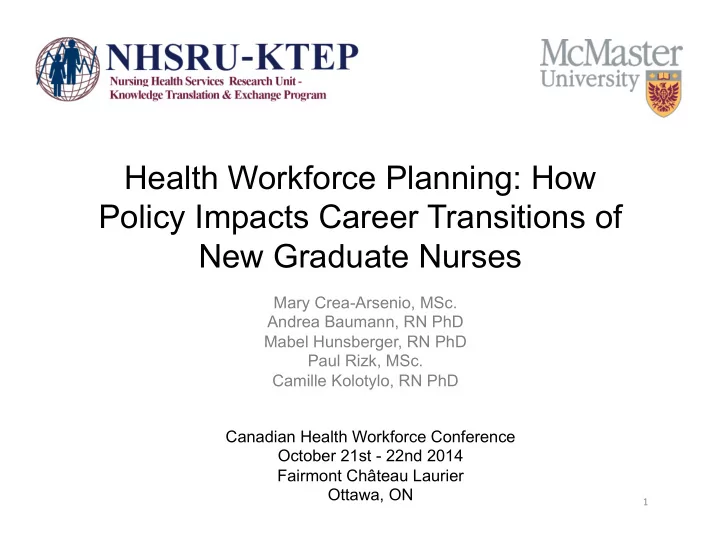

Health Workforce Planning: How Policy Impacts Career Transitions of New Graduate Nurses Mary Crea-Arsenio, MSc. Andrea Baumann, RN PhD Mabel Hunsberger, RN PhD Paul Rizk, MSc. Camille Kolotylo, RN PhD Canadian Health Workforce Conference October 21st - 22nd 2014 Fairmont Château Laurier Ottawa, ON 1 ¡
Outline Historical Context Examining the need for change • New graduate nurse employment Nurse employment initiatives • Nursing Graduate Guarantee (NGG) Impact of the NGG on new graduate • full-time employment • retention Conclusions 2
Historical context Private sector: • Increase “flexibilixzation”of workforces • Change in the employment relationship • Lack of security and commitment Public sector: • Healthcare restructuring occurred in 1990s • Increase in the casualization of the nursing workforce • Decreased supply of registered nurses (RNs) and registered practical nurses * (RPNs) 3 ¡ *In Ontario, licensed practical nurses are called registered practical nurses
Impact on the Nursing Workforce Total RPN Workforce 1994-2013 Total RN Workforce 1994-2013 ¡ 50,000 115,000 110,000 45,000 105,000 40,000 100,000 35,000 Count Count 95,000 30,000 90,000 25,000 85,000 20,000 80,000 15,000 75,000 1994 1995 1996 1997 1998 1999 2000 2001 2002 2003 2004 2005 2006 2007 2008 2009 2010 2011 2012 2013 1994 1995 1996 1997 1998 1999 2000 2001 2002 2003 2004 2005 2006 2007 2008 2009 2010 2011 2012 2013 Year of Renewal Year of Renewal Total Possible Workforce Employed in Nursing Total Possible Workforce Employed in Nursing Date of renewal counts reflects members who renewed at the end of the previous calendar year (e.g. 2012 data represents members who renewed at the end of 2011 for the 2012 practice year). Source: College of Nurses of Ontario (CNO), 2013. 4 ¡
Evidence to Policy Research showed • 75 percent of new graduates preferred full-time employment • 35 percent of new graduates were obtaining full-time positions 6 months after graduation Need for change • New graduate nurses would leave Ontario to seek employment elsewhere • New graduate nurses would leave the profession 5 Source: Baumann, Hunsberger, & Crea-Arsenio, 2012.
Nursing Graduate Guarantee • Launched in 2007 • Incentive funding for employers Ø hire new graduate nurses Ø temporary full-time supernumerary positions Ø six months • Evaluated annually Source: Baumann, Hunsberger, & Crea-Arsenio, 2013. 6
Purpose ¡ The purpose of this study was to examine the impact of the NGG on full-time employment and retention of nurse graduates six years after graduation. 7 ¡ 7 ¡
Data Sources Policy Impact on Nurse Employment (PINE) survey includes: • Demographic, employment, retrospective career transition, and retention data. College of Nurses of Ontario (CNO) registration database includes: • New member demographic and employment data 8 ¡
Sample – PINE Survey N % Total Sample 2367 100.0 NGG Participant NGG 1006 44.1 non-NGG 1275 55.9 Nurse Designation RN 1373 59.9 RPN 919 40.1 Year of Graduation 2007 176 7.7 2008 250 11.0 2009 320 14.0 2010 408 17.9 2011 502 22.0 2012 623 27.3 9 ¡
Impact of NGG on Full-Time Employment Proportion of Survey Respondents with Full-time Work Status 0.9 0.8 0.7 0.6 Proportion 0.5 RN Non-NGG 0.4 RN NGG 0.3 RPN Non-NGG RPN NGG 0.2 0.1 0 2008 2009 2010 2011 2012 Graduation Year 10 ¡
Do Preferences Count? 11
Career Transitions of New Graduate Nurses ¡ Impact of NGG on Retention ¡ 12 ¡
Proportion of Respondents that Stayed in First Organization of Employment 1 0.9 0.8 Proportion 0.7 RN NGG RN Non-NGG 0.6 RPN NGG RPN Non-NGG 0.5 0.4 0.3 2007 2008 2009 2010 2011 2012 Graduation Year 13
Proportion of Survey Respondents that stayed in Initial Position 1 0.9 0.8 Proportion 0.7 RN NGG RN Non-NGG 0.6 RPN NGG RPN Non-NGG 0.5 0.4 0.3 2007 2008 2009 2010 2011 2012 Year of Graduation 14 ¡
Conclusions Factors to consider in workforce planning • Government policy can impact career transitions of new graduates • Workforce integration of new nurses is critical to successful workforce planning • Optimal employment for new graduate nurses ensures nurses remain in the province and profession 15
Questions? Thank-you! 16 ¡
Contact Information Andrea Baumann, PhD Scientific Director Nursing Health Services Research Unit McMaster University Michael DeGroote Centre for Learning MDCL 3500 (905) 525-9140 ext. 22581 baumanna@mcmaster.ca www.nhsru.com 17 ¡
Recommend
More recommend